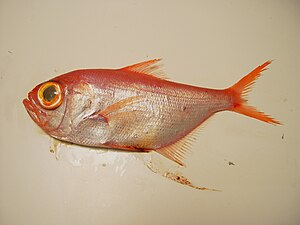Shiny slime head
| Shiny slime head | ||||||||||||
|---|---|---|---|---|---|---|---|---|---|---|---|---|

Shiny mucous head ( Beryx splendens ) |
||||||||||||
| Systematics | ||||||||||||
|
||||||||||||
| Scientific name | ||||||||||||
| Beryx splendens | ||||||||||||
| Lowe , 1834 |
The shiny mucous head , Beryx splendens , is a medium-depth marine fish that has been increasingly used industrially since the late 1960s. As a berycide, it belongs to the order Beryciformes , the more primitive barbedfish. The origin of Cuvier's generic name (1829) is not certain. According to theories, it goes back to βήρυξ <βήρηξ <βάραξ (possibly because of the similarity with perca = perch), the meaning of which is unclear.
description
It is a fish that lives on the continental slopes (180–1300 m or more) and over submarine mountains: wide-eyed, skin ( splendens , "bright") vermilion to scarlet ("Imperador, Kaiserbarsch"; fades when stressed: Sides silvery), d. H. the fish always looks black in the depths. At night it rises and moves away from the substrate into the open water, where it also spawns (in "winter": eggs repeatedly released in clumps; pelagic as well as the larvae. Young fish with extended second dorsal fin spine - see Fig. Of the Beryx decadactylus ). It lives socially and feeds (bathy- to meso pelagic ) on smaller fish, octopus and crustaceans. As an important food fish (with the appropriate equipment: trawls, ground nets, longlines caught) it is already threatened in some places because it reproduces only slowly (see also Hoplostethus atlanticus ).
The name "Schleimkopf" was given because of the well-developed head sideline system, which at the beginning (19th century) was only seen as producing "slime" (see illustration in Beryx decadactylus ); " Alfonsin (o), Alfonsim": because of its physiognomic similarity to a Spanish ruler (chin protruding). The body is strongly flattened on the sides, the edge of the abdomen therefore “sawn” (book name “sawbelly”).
The medium-sized scales (approx. 3 per vertebra; 24 vertebrae) have a soft padding on the free edge inside - the scales always stick out a little, the fish is rough. The scallops are not mobile (in contrast to the Percomorpha - actually spinoid instead of ctenoid scales ). Lacrimale in front with protruding thorn. Two supramaxillaria; Maxillary still involved at the edge of the mouth. Teeth (also on vomer and palatine) consistently small. Branchiostegal membrane with 8 (rarely 9) radii (in Perciformes, however, usually 7). At the gastric exit 23 to 30 pyloric tubes ( appendices pyloricae ). Up to 70 cm long, 4 kg in weight, 23 years old - the large individuals are rare because natural mortality (from predators) is high.
- Fin formula : D IV / 13-16, A IV / 26-30, PI / 17, VI / 8-11, C (18-) 19 (16 or 17 divided; stiffened with a few short anterior rays).
Occurrence
Close to the coast in all tropical to warm temperate seas, except the Mediterranean, Red Sea, Persian Gulf and Northeast Pacific (coasts of Canada; not or only lost to coasts of France and England as well as Hokkaidos and Patagonia). In 1996 attempts were made to establish a population off the coast of Liguria and it appears to be successful. On the basis of genetic analyzes it can be assumed that the species comprises only one population because the larvae ensure slow gene exchange worldwide; regional meristic differences are therefore due to developmental physiology.
literature
- William King Gregory: Fish skulls.- 1933. http://www.archive.org/stream/fishskullsstudyo00gregrich
- Richard Thomas Lowe: A history of the fishes of Madeira.- London 1843-1860. http://www.archive.org/stream/historyoffisheso00lowe
Web links
- Shiny slime head on Fishbase.org (English)
Single receipt
- ↑ Pape (1880) cites βαράκες as an ancient Greek festival at which "many horns were worn (on the head)" - from here Cuvier may have made the connection to the spinoid scales, whose small thorns resemble cattle horns.